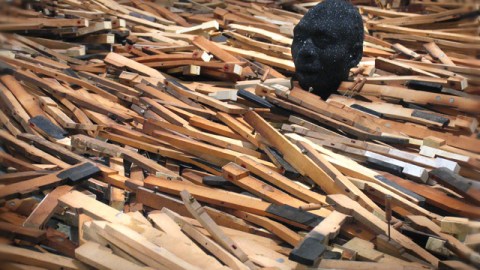Colossal Radcliffe Bailey Exhibit At Atlanta High Museum

I finally found one word to describe Memory as Medicine, the Radcliffe Bailey exhibition I saw last Saturday – colossal. More than mere paint on canvas, the huge multimedia selections on display at the High Museum in Atlanta, taken in the aggregate, are a colossus, a worthy monument to the trials and tribulations that have shaped the lives of Africans brought to America. It wasn’t until Sunday at our Labor Day gathering that I found out Bailey’s show was the first solo exhibit by an African American artist.
The sheer scale of many of the pieces, including the diorama Uprootedthat stretched on for twenty feet, would be overwhelming if it weren’t for the artist’s careful manipulation of the tonal variations between the items and his use of distinct layers. The most arresting piece in the whole show was Windward Coast, a massive installation that consisted of a black plaster cast of the head of an African American male emerging from beneath the thousands upon thousands of wooden piano keys Bailey had arranged to resemble the waves of the Atlantic Ocean.
For some artists, the overwhelmingly dire content of slavery evoked in Bailey’s themes of passage from Africa to America, and the universal passage he evokes in boats and the cosmos from the world of the living to the world of the infinite, might burden their work. But Bailey’s perspective is airborne, humanistic, full of hope. He takes the South’s legacy of slavery (the proverbial elephant in the room) and, instead of a bottomless gulf of pain, finds healing and wisdom.
Radcliffe Bailey draws from dark history to push his own art forward
As I marveled at the intricacies of one of the smaller works by Bailey depicting the journey of a slave ship, a middle aged white man and his young son were standing in front of me. It was as interesting to watch the interaction between father and son as it was to look at the work itself. The little boy’s reaction to the slave ship was literal, prompting him to ask questions about why the people in the picture were on the ship. The father’s answers were deliberate and direct explanations about the indignities of the slave trade, the kind of truth telling about America’s past that make it imperative for more top tier museums across the country to sponsor shows by African American artists like Radcliffe Bailey.





